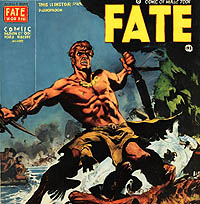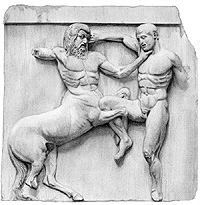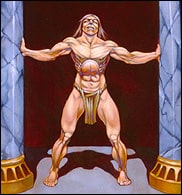Combat is simultaneous, except for ambushes and sneak attacks, in which the initiator gets to roll on the advantage table below with 1 D, adding their ambush or sneak attack skill level of zero for unskilled, and +1 through +5 for the five levels of skill: skilled, expert, veteran, superior and master.
1 –the enemy is warned and gains a free attack
2-4—no surprise, combat is simultaneous
5-6—brief surprise, you may fire and throw missiles against unaware targets. Attacks with hand-to-hand weapons are made at your combat score +6.
7-8—surprise, may fire and throw against point blank range. Attacks with hand-to-hand weapons are made at combat score +12.
9-plus—total surprise. Every attacker rolls 2 D. Those who do not roll a 2 damage your target. Those who roll a 12 may damage 2 targets.
A Character’s combat score consists of 2 or more numbers added together:
-1. The ability governing that weapon type in unskilled usage, such as toughness for unarmed combat, strength for two-handed weapons, plus
-2. The number of combats this character has survived.
-3. A combatant adds, for each skill level in that weapon type, the ability assigned to that weapon at that level. For instance, Bruggish is a veteran with one handed weapons, therefore, beyond adding agility, which every combatant, skilled or not, does when using one-handed weapons, Bruggish adds his strength for being skilled, his toughness for being an expert and his creativity for being a veteran.
Since skill points are accumulated through combat, resulting in more experienced fighters gaining very large advantages in combat with their favored weapon, and total combats are added, this system is heavily weighted towards the experienced combatant. However, combat is so deadly experience is hard won and characters do not gain some magic ability to sustain more damage as they increase in skill.
The characters then compare their scores and calculate the difference, resulting in a zero for both or a plus score for one and a minus score for the other.
Characters with an exact score, fighting at zero, only hit one another on the roll of a 7 or 12.
Characters with different scores, which is usually the case, roll to attack one another at the same time, scoring and delivering damage [which may yet be deflected by shields or armor or diverted attacks].
Once both combatants have rolled their die, and before they lift their cups, either may declare that he is diverting his attack to a defensive action, meaning if it is successful, that he does no damage to his opponent, but nullifies any successful attack by the foe, except for a 12 roll, which would then be treated as an ordinary stroke instead of an extraordinary one. These declarations are done first by the combatant with the deficit, or written down if the fight is equal at zero advantage.
The Combat Results Table
No die rolls are modified in combat. Combat is conducted in simultaneous rounds.
The number is that required for a combatant with the stated combat advantage or deficit to score a damaging stroke. All numbers higher than this roll also score. The exception is when combatants are perfectly matched at zero and they score only on a 7 or 12.
2—extraordinary failure
3—failure
4—plus 25 and higher
5—plus 13-24
6—plus 1 to 12
7—zero, scores on no other roll except for 12
8—minus 1 to 12
9—minus 13-24
10—minus 25 and lower
11—success, unless perfectly matched, than this result is a failure
12—extraordinary success
These combat results are intrinsically unfair to the novice and yet lethal to the veteran and even master.
Extraordinary Failure
2—slain by mishap
3—knocked unconscious by mishap
4—maimed by mishap [unconscious]
5—tripped, slipped, fell, may only defend next round
6—shield [1-3] or weapon [4-6] shattered
7—if your foe missed, they get a reroll
8—stripped of your weapon [they have it]
9—dropped your weapon
10—God thought you were getting cocky
11—You struck yourself. Roll damage D
12—It looked bad, really bad—you thought God hated you—and somehow you won through, striking an extraordinary stroke. Yes, roll on that table now and start going to church on Sunday…
Extraordinary Success
2—Before the Devil knows your dead! Check on failure table.
3—You may strike at an additional foe and he may strike back*
4—You may strike an additional foe*
5—You may strike at two additional foes*
6—You score maximum damage against your foe, but your weapon is stuck and you can’t get it out.
7—You slip and fall and it saves you from whatever you might have been hit with. Nullify foe’s stroke, all of them, even if you are being attacked by a pack.
8—You score two strokes against your foe, calculate damage separately, against a single foe only.
9—You strike through your foe so easily that you do half of the damage you scored on him against any companion of his in your reach.
10—You strike your foe, calculating damage, and disarm him.
11—You break your foe’s weapon and may calculate damage if you wish or accept his surrender.
12—Your enemy breaks, running like a coward, groveling like a slave or swearing to be your henchmen, as the game moderator judges most realistic under the circumstances. If this person is a leader or champion the entire enemy force might also break and run or submit.
Multiple Foes can Number 2 or 3. More cannot get at the single combatant.
The combatant fighting multiple foes calculates his ability, skill level and combats against their aggregate score and conducts 2 or 3 simultaneous combats in a row, with the highest scoring foe first and the lowest last. Below is an example.
Bruggish the Bull Breaker fights with his maul as a one-handed weapon, with which he has a veteran’s skill level of 3, governed by his agility of 7 [unskilled, base ability] and augmented by his Skilled ability of Strength 11, by his Expert ability of Toughness 10, by his Veteran ability of Creativity 5, and by his experience in 30 combats, for a total combat score of 63.
His three enemies, all night watchmen with, unskilled with cudgels for [add each watchman’s strength for a total of 23, and 9 combats between them, for a total of 32, places the watchmen in the minus-25 deficit and Bruggish in the plus-25. However, when facing the 2nd and 3rd foes, Bruggish will fight at zero, meaning he will only score with a 7 or 12, reflecting the necessity of him having to focus on one foe more than the others. If he tried to split his attention equally they would simply overwhelm him. This rule is based on real full contact stick fighting experiments with multiple foes.
Once a stroke is scored consult the shield and armor rules.
There is no, “you go I go” rhythm to real combat, especially with hand-to-hand combat that brings the striker into contact range with his foe, who may strike as well. This is especially true of group combat.
By the Wine Dark Sea
link › jameslafond.blogspot.com











